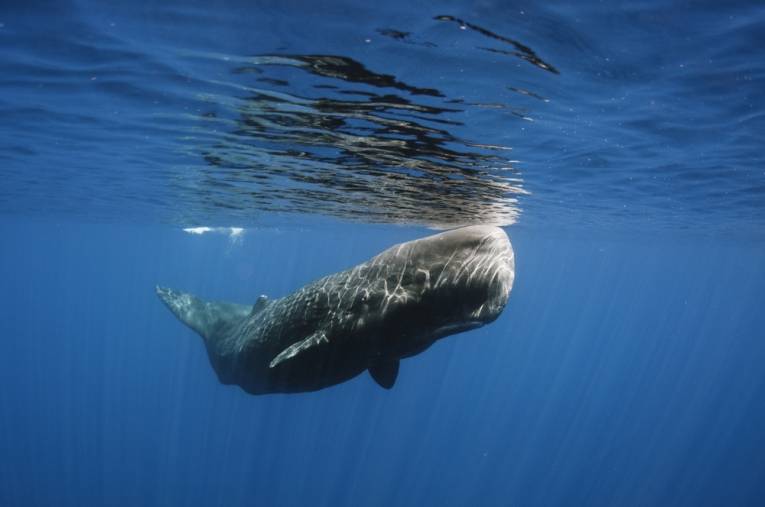The sperm whale is perhaps the most distinct of all whales. Being toothed, it could be distantly related to the dolphins, but its huge size, at 20 metres (60 feet) in length places it deep in our imagination as the great whale (eg. Moby Dick). There are no others like it, in fact. Two very small relatives are such distant cousins that they might as well be in a different family.
The head is so distinct that it measures one-third of the length (compare the blue whale's head which is less than one quarter of its length). The small under-slung jaw is contrasted with the massive rectangular, blunt nose, packed with sensory apparatus and the legendary spermaceti that gives this whale its name.
The flippers are short stubby "brakes," but that magnificent tail fluke is the equal of any other. The huge acceleration that tail exerts is largely in our imagination, as few can ever have witnessed a speeding sperm whale under the water.

Tail fluke of a diving sperm whale (Physeter macrocephalus), via Shutterstock
Vertical diving is naturally the forte of the tail and the whale. Depths of 3000m (2 miles) have been recorded, also giving it the record of 2 hours for longest dive. We know from the scars on the head why it dives so deep. Its famed prey is the giant squid. The sperm whale also has the largest brain of any animal, which probably indicates it is also one of the greatest hunters!
After surfacing after deep dives, the sounds the sperm whale makes are amazing. One kilometre away, the sound of the blow hole opening is like an explosion. Likewise, the loud splash after a two mile dive can be heard two miles away and involves a complete breach - the whole animal leaves the water.

Sperm whale illustration; Credit: Shutterstock
Communications between members of the large pods are often long-range echo-locations, each individual possessing a signature. These are equivalent of course to the echo-location of the bats and many other whales but also seem to maintain an inter-personal distance of around 100m and probably function similarly to cell-phones!
The most awful unheard noise is that emitted by a stranded whale. To the distress of many dogs, the call summons help from the rest of the pod offshore. Although human ears can't discern the frequency, the socialised whales cannot be stopped joining the caller on the beach, until the whole herd are involved. Killing the first whale is one possible solution to saving the whole group, which has been known to include a new-born, 70 females and the lead bull-whale. Bachelor herds don't seem to cohere so well and thereby often escape to the open sea.

Illustration of a sperm whale eating a giant squid via Shutterstock
All squid are eaten, especially the giant of the deep-sea, Moroteuthis robusta. However skate, lobster and cod make it more of a "European" in diet. The key hunting tactic might well be lying in wait for the giant and luminescent squid, presumable using its echo-location to the limit for it to catch such a fast moving prey. The spermaceti wax in the wonderful nose comes into play at depth, because it absorbs water and vastly increases its density and, naturally, that of the whole whale. This is where the name sperm whale originated, as the wax was used as oi
The other unique product of sperm whales is ambergris. It is washed up on beaches, expelled from the stomach or anus as a grey, crusty material, smelling a bit like propanol. It was a vital component of perfumes before synthetics took over and whales largely disappeared.
Half a million whales may exist in two main populations (northern and the bigger southern hemisphere population.) They all migrate toward the equator in autumn and the poles in spring. As the most hunted cetacean, sperm whales have held on magnificently against the odds, but the Japanese amazingly still hunt them (for "scientific" research.) Who could figure?










